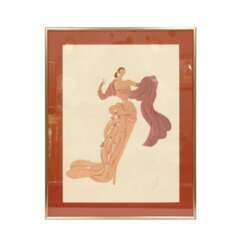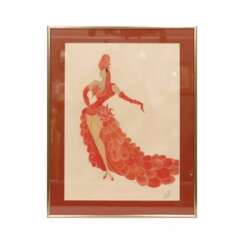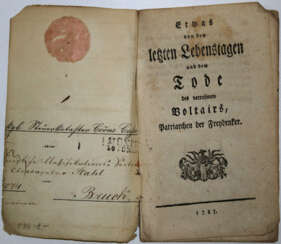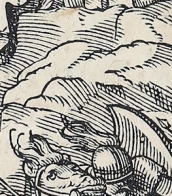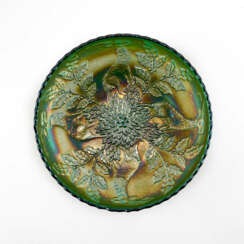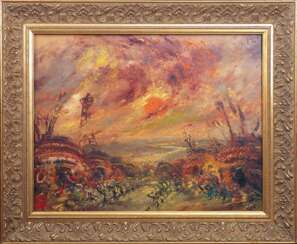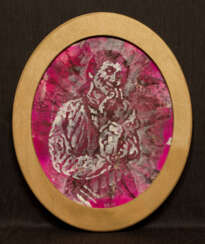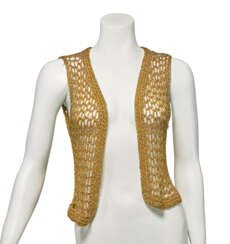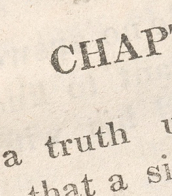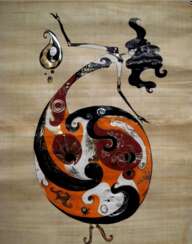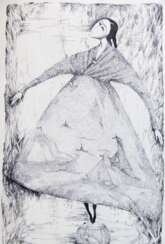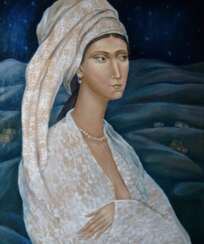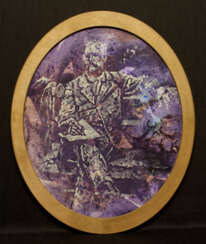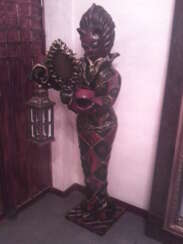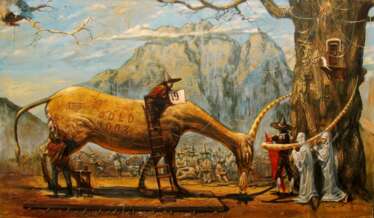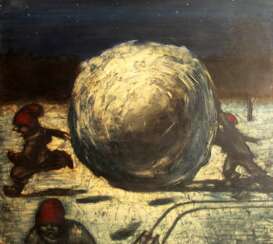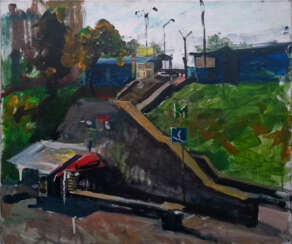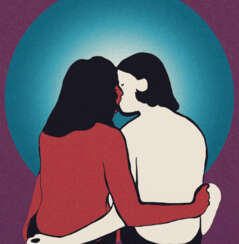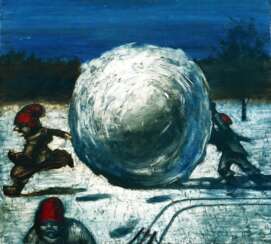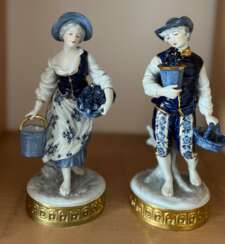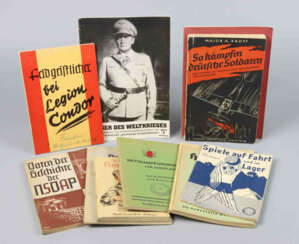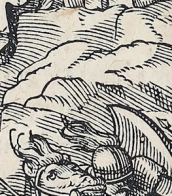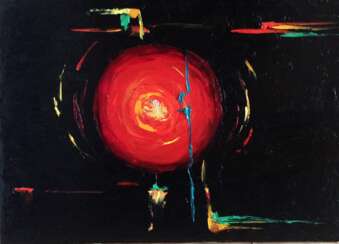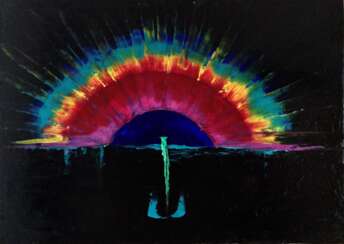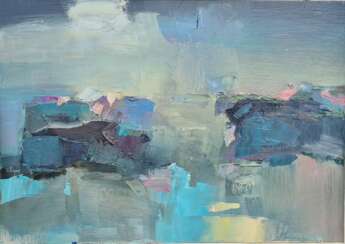210 Items by auctions and galleries:
stage
On the stage
Daniel Wille (b. 1987)  Shop Wille Daniel
Shop Wille Daniel

Daniel Wille
27.02.1987
Austria
In art I always was seeking for the opportunity to make the viewer feel the picture as something alive, to feel the presence. But not only with the help of classical techniques, or not only with the help of it, but more through associative, subconscious or intuitive.
Using various objects, fabrics, textures, you can create something you can touch to change, something that is exposed to the environment, natural and aging. And that can revive the canvas.
It was always paradoxical for me to feel impressionism more alive comparing to classical realism, I found the key to this answer in Alla prima techniques emotions and admiration are instantly imprinted on the canvas.
Therefore, I try to create work as quick as possible so as not to move out to another environment. To create a good picture you have to live it, survive it.
Even if the picture is not completed, then it will provide an opportunity viewer's imagination.
Everything you can imagine is real.- Picasso.
At recent moment I am working on a new direction "Anrealism".
Born in Samara, Russian Federation.
1987.
Studied interior design and architecture , joined the global art League 2014.
Was exhibiting works in Russia, USA, Israel.
2015 Relocated to Israel, joined the community of artists there.
In 2018 married and relocated to Austria where recently living.
Since childhood, I was surrounded by bunch of books about history of Italian art and architecture, and also most often visited this country with parents who were dealing with fashion boutiques. Grandmother was teacher of piano and singing , given private lessons. So house was fulfilled with atmosphere which motivated me to start creating from age of 3.

Artist shop
Wille Daniel
Austria
Number of products: 21
Special stage
Viktor Djevaga (b. 1962)  Shop Djevaga Viktor
Shop Djevaga Viktor

Viktor Djevaga
05.12.1962
Ukraine
Джевага Виктор. Родился в 1962 году в Одессе.
В 1978 окончил художественную школу по классу акварели. В основном график, хотя... Разработал дизайн и выпустил в свет многие журналы: «Зонтик» (журнал для детей), который издавала издательская фирма «Имидж-пресс», «Футбол-Интер» (первые номера) - фирма «ИнтерПресс», «Доктор Интерьер» (фирма «Аркадия»), «Альянс» и «Дом и Интерьер» (фирма «Альянс»), «Фонтан» (юмористический журнал, фирма «Аркадия»), журнал «Одесский Водный» (Союз выпускников Водного института), журнал «Судостроение и судоремонт» (руководитель проекта Николай Дубров). Дизайн - основная работа. Книги и иллюстрации для них, создание фирменного стиля для организаций, дизайн этикеток и оберток для любой оберточной продукции, буклеты, постеры, презентации и многое-многое другое. В свободное от работы время больше всего любит отдаваться графике и выдумыванию всякой всячины (фото инсталляции, новые журнальные проекты и т.д.),
Работы находятся в частных коллекциях Болгарии, Польши, Германии, США и других стран.

Artist shop
Djevaga Viktor
Ukraine
Number of products: 20
MARIA ZANKOVETSKA
Yurii Yermolenko (b. 1973) 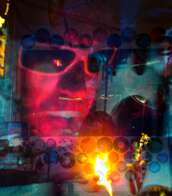 Shop Yermolenko Yurii
Shop Yermolenko Yurii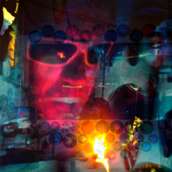

Yurii Yermolenko
02.10.1973
Ukraine
Yury Ermolenko – A Master of Fine Arts (MFA)
Born in 1973 Kiev (Ukraine) Lives and works in Kiev.
Education:
1980 – 1992 – T. Shevchenko Republican art school, Kiev, Ukraine
1992 – 1998 – National Academy of Fine Art and Architecture (NAFAA), Kiev, Ukraine
1998 – 2001 – Post-graduate education ( M.A.degree ), NAFAA, Kiev, Ukraine
2003 – Got a scholarship of Ministry of Culture of Poland ”GOUDE POLONIA”, Krakow, Poland
Main exhibitions:
2018 - "Garden of Wandering Geniuses" project, (Х.Л.А.М.), Kyiv, Ukraine.
2017 – 2018 – “MY FAVOURITE DOLLS” project, Tauvers Gallery international, Kiev, Ukraine
2017 – 2018 – “Flea Psychedelic Market” project, (Х.Л.А.М.), Kyiv, Ukraine
2016 – 2017 – In “Search of Dark Energy”, Vysehrad, Prague, Czech Republic; Hofburg Palace, Vienna, Austria.
2014 – 2015 – “Mу Favorite Dolls”, “Brothers in Arms”
2013 – “Facevinyl”
2013 – “Ukrainian Psychedel”, “Suitcases the Classics”
2013 – “Magical Garden”
2013 – “May be always be my mother, may there always be me”
2012 – “Conversion”
2012 – “Immigration to Cuba”
2011 – “Sings of Cuba”
2011 – “Ladies I didn`t get along with”
2010 – “Metaphysical Landscape of Zaporizhia”
2010 – “Metaphysical Landscape of Kaniv”
2010 – “A hedgehog jazz f**k”
2009 – “Eternal Values”
2009 – “Peruvian Toys”
2008 – “Death of Brands”
2007 – “Pink”
2007 – “Lolita’s on the Arena”
2007 – “Silicon”
2006 – “Paradise”
2006 – “Flea Market”
2005 – "Alice new!"
2005 – “Entomology of Souls”
2004 – "13. ICONOSTASIS"
2004 – “Hunting”
2003 – “KANIV – RAPAN”
2003 – “Baltic – Hel”
THE PROJECTS IN THE ART GROUP "TERRACES":
2002 – “Flash
2001 – “Indigo-Purring Cort”
2000 – “New York City”
2000 – “Flash”
1999 – “So good!”
1998 – “Shout on Plateaus”
1997 – “Dances on Colored Rope”
1997 – “Lighting Art and Painting Art”

Artist shop
Yermolenko Yurii
Ukraine
Number of products: 90
MYKOLA LYSENKO
Yurii Yermolenko (b. 1973)  Shop Yermolenko Yurii
Shop Yermolenko Yurii

Yurii Yermolenko
02.10.1973
Ukraine
Yury Ermolenko – A Master of Fine Arts (MFA)
Born in 1973 Kiev (Ukraine) Lives and works in Kiev.
Education:
1980 – 1992 – T. Shevchenko Republican art school, Kiev, Ukraine
1992 – 1998 – National Academy of Fine Art and Architecture (NAFAA), Kiev, Ukraine
1998 – 2001 – Post-graduate education ( M.A.degree ), NAFAA, Kiev, Ukraine
2003 – Got a scholarship of Ministry of Culture of Poland ”GOUDE POLONIA”, Krakow, Poland
Main exhibitions:
2018 - "Garden of Wandering Geniuses" project, (Х.Л.А.М.), Kyiv, Ukraine.
2017 – 2018 – “MY FAVOURITE DOLLS” project, Tauvers Gallery international, Kiev, Ukraine
2017 – 2018 – “Flea Psychedelic Market” project, (Х.Л.А.М.), Kyiv, Ukraine
2016 – 2017 – In “Search of Dark Energy”, Vysehrad, Prague, Czech Republic; Hofburg Palace, Vienna, Austria.
2014 – 2015 – “Mу Favorite Dolls”, “Brothers in Arms”
2013 – “Facevinyl”
2013 – “Ukrainian Psychedel”, “Suitcases the Classics”
2013 – “Magical Garden”
2013 – “May be always be my mother, may there always be me”
2012 – “Conversion”
2012 – “Immigration to Cuba”
2011 – “Sings of Cuba”
2011 – “Ladies I didn`t get along with”
2010 – “Metaphysical Landscape of Zaporizhia”
2010 – “Metaphysical Landscape of Kaniv”
2010 – “A hedgehog jazz f**k”
2009 – “Eternal Values”
2009 – “Peruvian Toys”
2008 – “Death of Brands”
2007 – “Pink”
2007 – “Lolita’s on the Arena”
2007 – “Silicon”
2006 – “Paradise”
2006 – “Flea Market”
2005 – "Alice new!"
2005 – “Entomology of Souls”
2004 – "13. ICONOSTASIS"
2004 – “Hunting”
2003 – “KANIV – RAPAN”
2003 – “Baltic – Hel”
THE PROJECTS IN THE ART GROUP "TERRACES":
2002 – “Flash
2001 – “Indigo-Purring Cort”
2000 – “New York City”
2000 – “Flash”
1999 – “So good!”
1998 – “Shout on Plateaus”
1997 – “Dances on Colored Rope”
1997 – “Lighting Art and Painting Art”

Artist shop
Yermolenko Yurii
Ukraine
Number of products: 90
Отражение
Andrey Dupont (b. 1968)  Shop Dupont Andrey
Shop Dupont Andrey

Andrey Dupont
13.09.1968
Russia
Родился в Санкт-Петербурге, Россия. С детства имею особое пристрастие к созданию предметов интерьера и формированию идеи и атмосферы жилого пространства.
Занимаюсь творчеством более 20 лет. Способности к изобразительному и прикладному искусству раскрылись в процессе многолетних эзотерических практик на пути саморазвития (практикую и преподаю Восточное боевое искусство 35лет). Создаю лепные интерьерные скульптуры из цемента с лакокрасочным покрытием; пишу концептуальные, символичные картины; снимаю свое кино, являясь актером, сценаристом и режиссером в одном лице; пишу стихи, рассказы и мотивирующие статьи. Мои фильмы, скетчи, ритуалы и ролики можно посмотреть на канале "Раскрытие личностного потенциала через у-шу". https://bit.ly/2Cd
Считаю творчество эффективным методом формирования окружающей реальности, замечательным способом развития личностных свойств, и прекрасным инструментом для выхода из сложных психологически жизненных ситуаций (всегда рекомендую своим ученикам и последователям).
I was born in St. Petersburg, Russia. Since my childhood, I have a particular fondness for creating interior items and shaping the idea and atmosphere of the living space. I have been doing creative work for over 20 years. My abilities for fine and applied arts were revealed in the process of esoteric practices on the path of self-development which is considered by me as a meaning of my whole life for many years. I create interior sculptures stuccoing them from cement with paintwork; I paint conceptual, symbolic pictures; I shoot my own movie, being an actor, screenwriter and director for every one of them; I write poems, stories and motivating articles. My films, sketches, rituals and videos can be viewed on the channel "Revealing personal potential through wushu". I consider creativity to be an effective method of shaping tthe surrounding reality, a wonderful way to develop personal properties, and an excellent tool for getting out of psychologically difficult life situations.

Artist shop
Dupont Andrey
Russia
Number of products: 25
Kyiv subway station "Beresteiska" Collage
Viktoria Voloshina (b. 2000)  Shop Voloshina Viktoria
Shop Voloshina Viktoria

Viktoria Voloshina
07.06.2000
Ukraine
Я – современная художница из Украины 2000 года рождения. Увлекаясь искусством с детства, в более зрелом возрасте я поняла что оно всегда будет неотъемлемой частью моей жизни. Мой стиль формировался годами проб и экспериментов как с тематикой произведений, так и с материалами для их создания, окончательно сформировав свой стиль в начале 2018того, найдя отклик души в линиях архитектуры, настроении улиц, истории мест и их изменчивости.
С тех пор большая часть моих работ стала связана с урбанистикой, а в качестве материала в предпочтениях акрил из за его быстрого схватывания, позволяющего запечатлеть мимолётное настроение и атмосферу того или иного пейзажа. Все пейзажи, которые отображены в моих картинах - это места Украины, преимущественно Киева. Можно сказать, что искусство стало для меня своеобразной "терапией" и успокоением, и мне хочется что бы глядя на мои работы зрители ощущали то же самое, созерцая сдержанную гамму и локальные мелкие детали.
Выпускница ДХСШ им.Т.Г.Шевченка
В 2018 поступила в НАОМА

Artist shop
Voloshina Viktoria
Ukraine
Number of products: 14
Lovers
Arseniy Kaluzhniy (b. 2002) 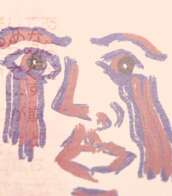 Shop Kaluzhniy Arseniy
Shop Kaluzhniy Arseniy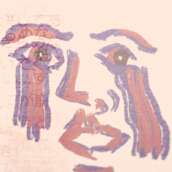

Arseniy Kaluzhniy
02.03.2002
Russia
My name is Arseny. I'm 19 years old. I am a student at Moscow University for the Humanities. I am engaged in advertising, design and decoration. From an early age, I paint various works, in different styles. I put my soul into every work and really appreciate them. Each painting has its own story, which is attached to it. I mean, these are not just paintings, these are me.

Artist shop
Kaluzhniy Arseniy
Russia
Number of products: 4
CHRISTMAS ENTERTAINMENTS
Sergiy Roy (b. 1958)  Shop Roy Sergiy
Shop Roy Sergiy

Sergiy Roy
04.04.1958
Ukraine
EXHIBITIONS:
INTERNATIONAL ART EXHIBITION,
MOSKOW, RUSSIA, WARSAW, POLAND, 1984
BASHKIRTSEV’S ART EXHIBITION, MUSEUM OF FINE ART, POLTAVA, UKRAINE, 1988
AVAN/ART IN ROVANIEMI, FINLAND, 1990
ANNUAL NATIONAL ART EXHIBITION, KYIV, UKRAINE, 1990
AVAN/ART, MUSEUM OF FINE ART, MURMANSK, RUSSIA, 1990
AVAN/ART IN JACKSONVILLE, KENT GALLERY, JACKSONVILLE, FLORIDA, USA, 1991
AVAN/ART IN JACKSONVILLE, DAWNTOWN GALLERY, JACKSONVILLE, FLORIDA, USA, 1991
ME+ME+ME+ME+…/AVAN CENTER OF CULTURE MURMANSK, RUSSIA, 1992
NATIONAL EXHIBITION ART GALLERY, KIYV, UKRAINE, 1993
PAN-UKRAINE, DNIPROPETROVSK, UKRAINE, 1995
EXHIBITION MODERN ART GALLERY, POLTAVA, UKRAINE, 2003
REGIONAL EXHIBITION MODERN ART GALLERY, POLTAVA, UKRAINE, 2005
REGIONAL EXHIBITION MODERN ART GALLERY, POLTAVA, UKRAINE, 2007
KYIV-ART. 2008 HOUSE OF TEACHER ,KYIV , UKRAINE 2008
M-ART GALLERY KHARKIV, UKRAINE 2010
IN GARDENS OF VICTORY GALLERY , ODESSA, UKRAINE 2011
Florence Design Week "Crossing People" Exhibition,FLORENCE,ITALY,2013
Gallery Fine ART, POLTAVA,UKRAINE,2013
Gallery " TRYPTYH", KYIV,UKRAINE,2014
Fine ART Gallery ,POLTAVA,UKRAINE,2014
Ukrainian Free Universety, MUNKHEN,GERMANY,2014-2015
ARTGESCHOSS, internationale kunstausstellung, Salzgitter Bad,GERMANY,2017
Art Revolution Taipei,Taiwan , 台北新藝術博覽會,2018
Private collections:
Mr. Roman Kupchinsky (USA, New York)
Dr. Ulf Bethmann (Germany, Hamburg)
Ms. Monika Platek (Poland, Krakov)
Museums and collection:
Jacksonville College (Florida, USA);
Khmelnitsckiy National Art Museum (Ukraine);
Poltava Art Museum (Ukraine);
Modern Art Gallery Poltava (Ukraine);
Austria, Australia, Dubai, USA, Germany, England, Russia, Israel, Irland, New Seland, Taiwan, Ukraine,Poland.

Artist shop
Roy Sergiy
Ukraine
Number of products: 207
ORGASM-1
Anna Kozyreva (b. 1986)  Shop Kozyreva Anna
Shop Kozyreva Anna

Anna Kozyreva
28.04.1986
Ukraine
Меня зовут Анна Козырева.
Я родилась в 1986 году в г.Киеве, Украина, где работаю и проживаю сейчас.
В моей семье не было художников. У нас не было картин на стенах, мне не рассказывали о людях творчества или о предметах искусства. Тем не менее, очень явно помню, что имела мечту в возрасте 7-8 лет. Я хотела писать маслом. Это желание было необъяснимым, не понятно чем навеянным.
Во второй раз желание вышло наружу в осознанном возрасте и предопределило мою судьбу)
Особая страсть у меня к графике. Мне нравится рисовать эмоции, без цвета они передаются сильнее и глубже. Очень часто моя графика двойственна, там заложены одновременно разные эмоции. Вы увидите то, что будет ближе Вашему внутреннему состоянию. Не исключено, что и все )
Страсть к черно-белым рисункам перешла частично и на мою живопись. Я обожаю контрасты. Поэтому картины или яркие и цветные(акцент на «сочность» сюжета) или черно-белые, но более глубокие в эмоциональном восприятии.
Прямо сейчас я создаю серию работ интимного характера без использования ярких красок. У Вас уже есть возможность эти картины увидеть.
Для меня, нежные постельные сцены – это время «срывания масок», тотальной открытости, это время самой большой нашей уязвимости и искреннего доверия, это время чувств.
Я рисую маслом, карандашом, углем, ручкой, делаю коллажи.
Приоритетная техника реализм.
Сегодня мои картины находятся в частных коллекциях в Украины, России и Европе, США.

Artist shop
Kozyreva Anna
Ukraine
Number of products: 26
ORGASM-2
Anna Kozyreva (b. 1986)  Shop Kozyreva Anna
Shop Kozyreva Anna

Anna Kozyreva
28.04.1986
Ukraine
Меня зовут Анна Козырева.
Я родилась в 1986 году в г.Киеве, Украина, где работаю и проживаю сейчас.
В моей семье не было художников. У нас не было картин на стенах, мне не рассказывали о людях творчества или о предметах искусства. Тем не менее, очень явно помню, что имела мечту в возрасте 7-8 лет. Я хотела писать маслом. Это желание было необъяснимым, не понятно чем навеянным.
Во второй раз желание вышло наружу в осознанном возрасте и предопределило мою судьбу)
Особая страсть у меня к графике. Мне нравится рисовать эмоции, без цвета они передаются сильнее и глубже. Очень часто моя графика двойственна, там заложены одновременно разные эмоции. Вы увидите то, что будет ближе Вашему внутреннему состоянию. Не исключено, что и все )
Страсть к черно-белым рисункам перешла частично и на мою живопись. Я обожаю контрасты. Поэтому картины или яркие и цветные(акцент на «сочность» сюжета) или черно-белые, но более глубокие в эмоциональном восприятии.
Прямо сейчас я создаю серию работ интимного характера без использования ярких красок. У Вас уже есть возможность эти картины увидеть.
Для меня, нежные постельные сцены – это время «срывания масок», тотальной открытости, это время самой большой нашей уязвимости и искреннего доверия, это время чувств.
Я рисую маслом, карандашом, углем, ручкой, делаю коллажи.
Приоритетная техника реализм.
Сегодня мои картины находятся в частных коллекциях в Украины, России и Европе, США.

Artist shop
Kozyreva Anna
Ukraine
Number of products: 26
ORGASM-3
Anna Kozyreva (b. 1986)  Shop Kozyreva Anna
Shop Kozyreva Anna

Anna Kozyreva
28.04.1986
Ukraine
Меня зовут Анна Козырева.
Я родилась в 1986 году в г.Киеве, Украина, где работаю и проживаю сейчас.
В моей семье не было художников. У нас не было картин на стенах, мне не рассказывали о людях творчества или о предметах искусства. Тем не менее, очень явно помню, что имела мечту в возрасте 7-8 лет. Я хотела писать маслом. Это желание было необъяснимым, не понятно чем навеянным.
Во второй раз желание вышло наружу в осознанном возрасте и предопределило мою судьбу)
Особая страсть у меня к графике. Мне нравится рисовать эмоции, без цвета они передаются сильнее и глубже. Очень часто моя графика двойственна, там заложены одновременно разные эмоции. Вы увидите то, что будет ближе Вашему внутреннему состоянию. Не исключено, что и все )
Страсть к черно-белым рисункам перешла частично и на мою живопись. Я обожаю контрасты. Поэтому картины или яркие и цветные(акцент на «сочность» сюжета) или черно-белые, но более глубокие в эмоциональном восприятии.
Прямо сейчас я создаю серию работ интимного характера без использования ярких красок. У Вас уже есть возможность эти картины увидеть.
Для меня, нежные постельные сцены – это время «срывания масок», тотальной открытости, это время самой большой нашей уязвимости и искреннего доверия, это время чувств.
Я рисую маслом, карандашом, углем, ручкой, делаю коллажи.
Приоритетная техника реализм.
Сегодня мои картины находятся в частных коллекциях в Украины, России и Европе, США.

Artist shop
Kozyreva Anna
Ukraine
Number of products: 26
The Versatility of Creation
Julia Dyachenko (b. 1977)  Shop Dyachenko Julia
Shop Dyachenko Julia

Julia Dyachenko
05.11.1977
Russia
Julia Dyachenko is Contemporary Abstract Artist, based in Moscow, Russia.
Eurasian Art Union member since 2021.
Julia Dyachenko comes fr om one of the harshest regions of Russia — Siberia wh ere cold, snow and savage scenery create special living conditions. It was the beauty of local landscapes that has impressed her since her childhood and has inspired to express her feelings through painting. Julia wanted to more fully express her experience through the visualization of unspoken sensations. The result was a series of artworks in the abstract impressionism genre.
Her artworks constantly participate in international exhibitions and competitions

Artist shop
Dyachenko Julia
Russia
Number of products: 5
In Peace
Julia Dyachenko (b. 1977)  Shop Dyachenko Julia
Shop Dyachenko Julia

Julia Dyachenko
05.11.1977
Russia
Julia Dyachenko is Contemporary Abstract Artist, based in Moscow, Russia.
Eurasian Art Union member since 2021.
Julia Dyachenko comes fr om one of the harshest regions of Russia — Siberia wh ere cold, snow and savage scenery create special living conditions. It was the beauty of local landscapes that has impressed her since her childhood and has inspired to express her feelings through painting. Julia wanted to more fully express her experience through the visualization of unspoken sensations. The result was a series of artworks in the abstract impressionism genre.
Her artworks constantly participate in international exhibitions and competitions

Artist shop
Dyachenko Julia
Russia
Number of products: 5
